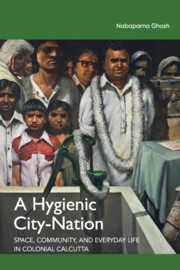Book contents
- Frontmatter
- Contents
- List of Figures, Tables, and Boxes
- List of Abbreviations
- Acknowledgements
- Introduction
- 1 The Black Town, Spaces of Pathology, and a Hindu Discourse of Citizenship
- 2 The Calcutta Improvement Trust: Racialized Hygiene, Expropriation, and Resistance by Religion
- 3 A City-Nation: Paras, Hygiene, and Swaraj
- 4 A New Black Town: Recolonizing Calcutta’s Bustees
- Epilogue
- Glossary
- Bibliography
- Index
1 - The Black Town, Spaces of Pathology, and a Hindu Discourse ofCitizenship
Published online by Cambridge University Press: 26 June 2020
- Frontmatter
- Contents
- List of Figures, Tables, and Boxes
- List of Abbreviations
- Acknowledgements
- Introduction
- 1 The Black Town, Spaces of Pathology, and a Hindu Discourse of Citizenship
- 2 The Calcutta Improvement Trust: Racialized Hygiene, Expropriation, and Resistance by Religion
- 3 A City-Nation: Paras, Hygiene, and Swaraj
- 4 A New Black Town: Recolonizing Calcutta’s Bustees
- Epilogue
- Glossary
- Bibliography
- Index
Summary
Koriya buddhir koushol
Pultah theke anle jol
Nikaash hochche moyla jol, koreche prostut drainagekol,
Dhulo thame dile jol. swatontro ek kol …
Machine te dile dom, korey jhomjhom, teje beroywater.
—Rupchand Pakshi(With cleverness immense/Water from Pultah commence/Dirty water runs out,that's what this drainage contraption is about/With water settlesdust, a unique device to trust/Rev up the machine, hear it gurgle, aswater gushes out.)
The British in 1869 inaugurated a brand-new machine to filter water atPultah, a small town near Calcutta. A few years later, the urban poetRupchand Pakshi wrote the poem ‘Dhonyo Sohor Kolkata’, anexcerpt of which is cited above. The poem chronicles the wonder that thewaterworks produced among Calcuttans as they watched machines sifting dirtand pumping filtered water into conduits that then supplied city-houses withclean water. Pakshi described the filtration process as buddhirkoushol: a demonstration of human intelligence. But at the sametime, he employed the English words ‘drainage’,‘machine’, and ‘water’ to argue that the scienceof filtration was incompatible to the city's cultural geography. Thethree English words signalled that the filtration processes were indeed partof a larger colonizing culture.
Given clean water is a basic human necessity, why did Pakshi describe thefiltration paraphernalia as a tool of colonialism? Pakshi's concern,I argue, fitted well within a broader climate of resistance that Britishcivic improvements had shaped in nineteenth-century Calcutta. The Britishimported town improvements—both their plans and theapparatus—from Europe and enforced these on the city, withouttailoring these to meet Calcutta's diverse cultural needs. Forexample, the British introduced subterranean sewers that required Indians toforego their caste and religious practices. Indian city dwellers, however,refused to give up their caste practices; Calcutta's culturalgeography resisted the new improvements. To overcome resistance, the Britishinitiated a process of ‘grafting’ that involved a brute forceto homogenize space by eliminating cultural differences.
A British corporation, James Watt & Company, that designed and soldsteam engines used the plans of William Clark, an English civil engineer, toconstruct the Pultah waterworks. With the paraphernalia imported fromLondon, the waterworks were a technological and visual wonder.
- Type
- Chapter
- Information
- A Hygienic City-NationSpace, Community, and Everyday Life in Colonial Calcutta, pp. 25 - 67Publisher: Cambridge University PressPrint publication year: 2020



